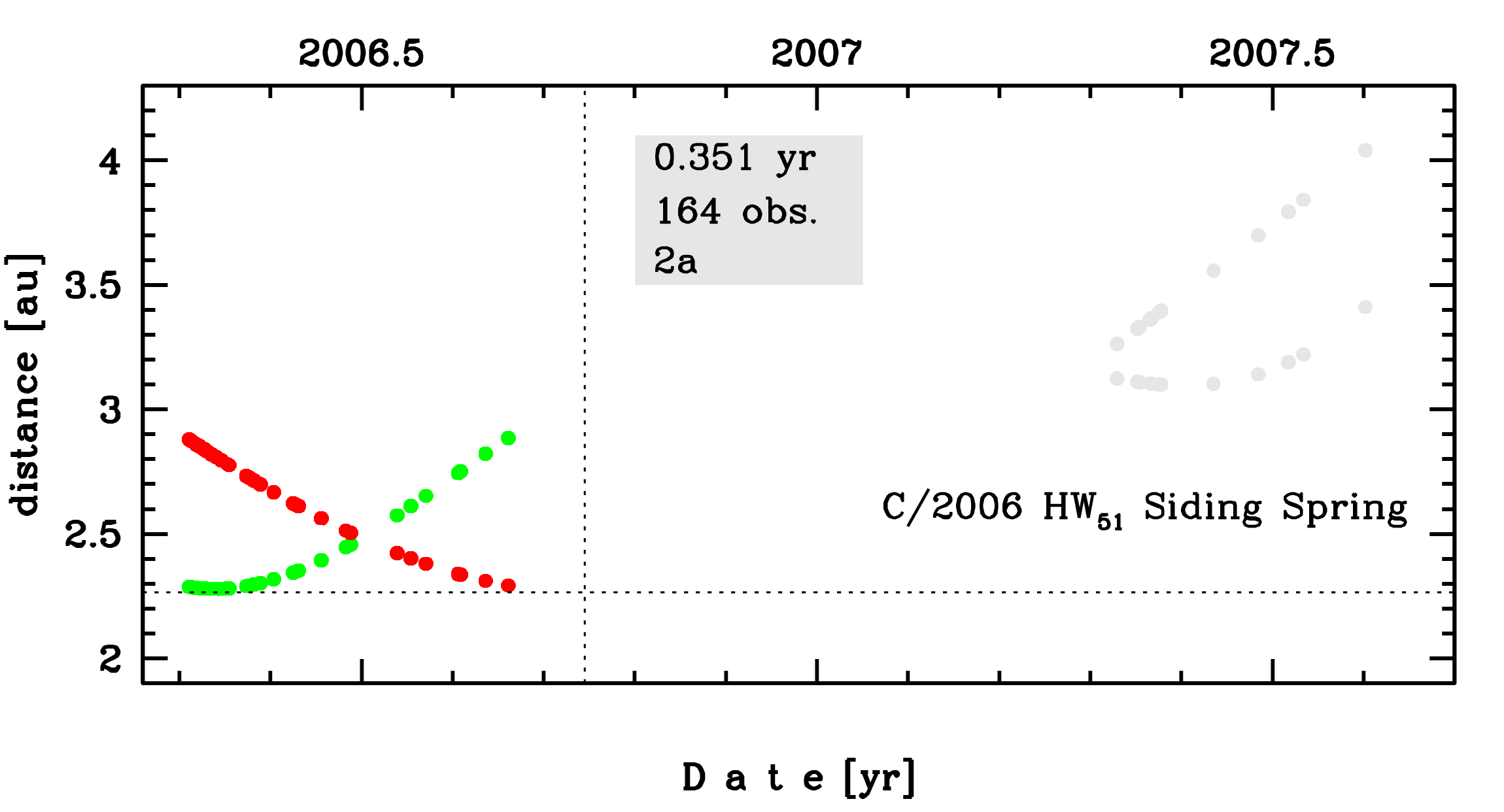C/2006 HW51 Siding Spring
more info
Comet C/2006 HW51 was discovered on 23 April 2006 with Siding Spring; that is about 5 months before its perihelion passage. It was observed until 7 August 2007 (see picture).
Comet had its closest approach to the Earth on 3 May 2006 (2.280 au), 10 days after its discovery.
Here, two solutions based on entire data set (a6 and n5) are very similar quality, and in Królikowska and Dybczyński 2013 we recomended pure GR solution for past and future orbital evolution. Both these solutions are based on data spanning over 1.29 yr in a range of heliocentric distances: 2.87 au – 2.259 au (perihelion) – 4.04 au. Here, we chose the NG solution as preferred;see Królikowska 2020.
This Oort spike comet suffers tiny planetary perturbations during its passage through the planetary system (compare original and future barycentric orbits for preferred orbit).
Comet had its closest approach to the Earth on 3 May 2006 (2.280 au), 10 days after its discovery.
Here, two solutions based on entire data set (a6 and n5) are very similar quality, and in Królikowska and Dybczyński 2013 we recomended pure GR solution for past and future orbital evolution. Both these solutions are based on data spanning over 1.29 yr in a range of heliocentric distances: 2.87 au – 2.259 au (perihelion) – 4.04 au. Here, we chose the NG solution as preferred;see Królikowska 2020.
This Oort spike comet suffers tiny planetary perturbations during its passage through the planetary system (compare original and future barycentric orbits for preferred orbit).
| solution description | ||
|---|---|---|
| number of observations | 164 | |
| data interval | 2006 04 23 – 2006 08 29 | |
| data arc selection | data generally limited to pre-perihelion (PRE) | |
| range of heliocentric distances | 2.88 au – 2.29au | |
| detectability of NG effects in the comet's motion | comet with determinable NG~orbit | |
| type of model of motion | GR - gravitational orbit | |
| data weighting | YES | |
| number of residuals | 316 | |
| RMS [arcseconds] | 0.29 | |
| orbit quality class | 2a | |
| previous orbit statistics, both Galactic and stellar perturbations were taken into account | ||
|---|---|---|
| no. of returning VCs in the swarm | 4881 | * |
| no. of escaping VCs in the swarm | 120 | |
| no. of hyperbolas among escaping VCs in the swarm | 0 | |
| previous reciprocal semi-major axis [10-6 au-1] | 20.30 – 26.12 – 32.25 | R |
| previous perihelion distance [au] | 970 – 1300 – 1900 | R |
| previous aphelion distance [103 au] | 61 – 75 – 97 | R |
| time interval to previous perihelion [Myr] | 5 – 7 – 10 | R |
| percentage of VCs with qprev > 20 | 100 | |
| previous_g orbit statistics, here only the Galactic tide has been included | ||
|---|---|---|
| no. of returning VCs in the swarm | 4587 | * |
| no. of escaping VCs in the swarm | 414 | |
| no. of hyperbolas among escaping VCs in the swarm | 1 | |
| previous reciprocal semi-major axis [10-6 au-1] | 19.20 – 25.39 – 32.97 | R |
| previous perihelion distance [au] | 16 – 91 – 560 | R |
| previous aphelion distance [103 au] | 61 – 79 – 100 | R |
| time interval to previous perihelion [Myr] | 5.2 – 7.7 – 11 | R |
| percentage of VCs with qprev < 10 | 5 | |
| percentage of VCs with 10 < qprev < 20 | 9 | |
| percentage of VCs with qprev > 20 | 86 | |
